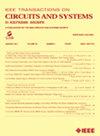Hardware-Optimized Regression Tree-Based Sigmoid and Tanh Functions for Machine Learning Applications
IF 4
2区 工程技术
Q2 ENGINEERING, ELECTRICAL & ELECTRONIC
IEEE Transactions on Circuits and Systems II: Express Briefs
Pub Date : 2024-10-23
DOI:10.1109/TCSII.2024.3485493
引用次数: 0
Abstract
The sigmoid and机器学习应用中基于硬件优化回归树的Sigmoid和Tanh函数
s型函数和双曲型函数tanh是人工神经网络中最常用的非线性激活函数。这些函数包含指数项以引入非线性,这在硬件上实现时会带来重大挑战。本文介绍了一种利用回归树和线性回归实现sigmoid和tanh函数的新方法。该方法利用回归树将其非线性区域划分为小段。这些部分进一步近似使用线性回归技术,最佳拟合线。实验结果表明,与精确函数相比,sigmoid函数和tanh函数的平均误差分别为$4\ × 10^{-4}$和$9\ × 10^{-4}$。在硬件上实现时,上述函数的平均误差比当前最佳方法分别减少24.52%和35.71%。此外,sigmoid和tanh函数的硬件实现具有更高的面积、功耗和延迟效率,与其他最先进的设计相比,显示了这种方法的有效性。
本文章由计算机程序翻译,如有差异,请以英文原文为准。
求助全文
约1分钟内获得全文
求助全文
来源期刊
CiteScore
7.90
自引率
20.50%
发文量
883
审稿时长
3.0 months
期刊介绍:
TCAS II publishes brief papers in the field specified by the theory, analysis, design, and practical implementations of circuits, and the application of circuit techniques to systems and to signal processing. Included is the whole spectrum from basic scientific theory to industrial applications. The field of interest covered includes:
Circuits: Analog, Digital and Mixed Signal Circuits and Systems
Nonlinear Circuits and Systems, Integrated Sensors, MEMS and Systems on Chip, Nanoscale Circuits and Systems, Optoelectronic
Circuits and Systems, Power Electronics and Systems
Software for Analog-and-Logic Circuits and Systems
Control aspects of Circuits and Systems.

 求助内容:
求助内容: 应助结果提醒方式:
应助结果提醒方式:


